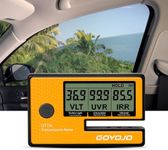Buying Guide for the Best Photographic Light Meters
Choosing the right photographic light meter can significantly enhance your photography by ensuring accurate exposure settings. Light meters measure the amount of light in a scene, helping you determine the optimal camera settings for the best possible shot. When selecting a light meter, it's important to consider several key specifications to ensure it meets your specific needs and preferences.Type of Light MeterLight meters come in two main types: incident and reflective. Incident light meters measure the light falling on the subject, while reflective light meters measure the light bouncing off the subject. Incident meters are generally more accurate for determining exposure because they are not influenced by the subject's color or reflectivity. Reflective meters, on the other hand, are built into most cameras and are useful for quick readings. Choose an incident meter if you need precise control over exposure, especially in studio settings. Reflective meters are more convenient for general photography.
Digital vs. AnalogLight meters can be digital or analog. Digital light meters display readings on an LCD screen and often come with additional features like memory storage and data logging. Analog meters use a needle to indicate the light reading. Digital meters are generally easier to read and more versatile, making them suitable for most photographers. Analog meters, while less common, can be preferred by those who appreciate a more tactile, traditional approach. Consider a digital meter for its ease of use and additional functionalities, especially if you are a beginner or need advanced features.
Measuring RangeThe measuring range of a light meter indicates the range of light levels it can accurately measure, from very low light to very bright light. This is important because it determines the versatility of the meter in different lighting conditions. A wider measuring range is beneficial if you shoot in varied environments, from dimly lit interiors to bright outdoor scenes. If you primarily shoot in controlled lighting conditions, a narrower range may suffice. Assess your typical shooting environments to determine the appropriate measuring range for your needs.
Flash MeteringFlash metering is a feature that allows the light meter to measure the output of a flash or strobe light. This is crucial for studio photography and situations where artificial lighting is used. Some light meters can measure both continuous light and flash, while others are designed specifically for one type. If you frequently use flash in your photography, ensure the light meter you choose has flash metering capabilities. For natural light photographers, this feature may be less important.
Display and InterfaceThe display and interface of a light meter affect how easily you can read and interpret the measurements. Look for a clear, easy-to-read display, preferably with backlighting for use in low light conditions. The interface should be intuitive, with accessible buttons and menus. A user-friendly interface is particularly important if you are new to using light meters. Consider your comfort with technology and how quickly you need to access and adjust settings when choosing a light meter.
Size and PortabilityThe size and portability of a light meter can influence how often and where you use it. Compact, lightweight meters are easier to carry around and can be more convenient for on-the-go photography. Larger meters may offer more features but can be cumbersome to transport. If you travel frequently or need a meter for outdoor shoots, a smaller, portable model may be ideal. For studio work, size may be less of a concern, allowing you to opt for a more feature-rich, larger meter.























